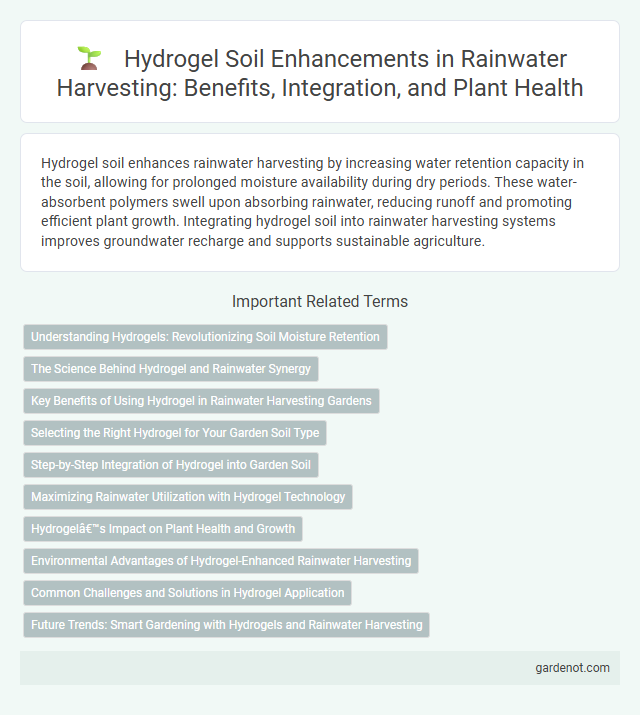Hydrogel soil enhances rainwater harvesting by increasing water retention capacity in the soil, allowing for prolonged moisture availability during dry periods. These water-absorbent polymers swell upon absorbing rainwater, reducing runoff and promoting efficient plant growth. Integrating hydrogel soil into rainwater harvesting systems improves groundwater recharge and supports sustainable agriculture.
Understanding Hydrogels: Revolutionizing Soil Moisture Retention
Hydrogels are superabsorbent polymers that significantly enhance soil moisture retention by absorbing and releasing water gradually, making them ideal for rainwater harvesting applications. These materials improve soil structure, reduce irrigation frequency, and promote plant growth even in arid conditions by maintaining consistent soil hydration. Incorporating hydrogels into soil increases water use efficiency and supports sustainable agriculture by minimizing water loss through evaporation and runoff.
The Science Behind Hydrogel and Rainwater Synergy
Hydrogels are superabsorbent polymers capable of retaining up to 500 times their weight in water, enhancing soil moisture retention and promoting efficient rainwater utilization. When integrated into soil, hydrogels reduce runoff, increase infiltration rates, and provide a sustained release of water to plant roots, optimizing rainwater harvesting systems. This synergy between hydrogels and rainwater improves crop resilience during droughts and contributes to sustainable soil management practices.
Key Benefits of Using Hydrogel in Rainwater Harvesting Gardens
Hydrogel enhances rainwater harvesting gardens by significantly improving soil moisture retention, reducing irrigation frequency, and promoting healthier plant growth. Its water-superabsorbent polymers absorb and store large volumes of water, slowly releasing it to plant roots during dry periods. This leads to increased water use efficiency and supports sustainable garden ecosystems in drought-prone areas.
Selecting the Right Hydrogel for Your Garden Soil Type
Selecting the right hydrogel for garden soil type involves understanding the soil's texture and water retention needs, as hydrogels vary in absorption and release rates. Sandy soils benefit from superabsorbent polymers that enhance moisture retention, while clay soils require hydrogels that improve aeration without causing waterlogging. Choosing a hydrogel compatible with the garden's soil chemistry maximizes rainwater harvesting efficiency and supports healthy plant growth.
Step-by-Step Integration of Hydrogel into Garden Soil
Incorporate hydrogel by first measuring the recommended amount based on garden soil volume, typically 0.1% to 0.5% by weight. Mix the dry hydrogel granules thoroughly into the top 6-8 inches of soil to ensure even water retention and root access. Water the soil immediately after application to activate the hydrogel's water-absorbing properties, enhancing moisture availability for plants during dry periods.
Maximizing Rainwater Utilization with Hydrogel Technology
Hydrogel technology enhances rainwater harvesting by significantly increasing soil water retention capacity, reducing runoff and promoting efficient water absorption in agricultural and urban landscapes. These superabsorbent polymers swell on contact with water, releasing moisture gradually to plant roots, thereby maximizing rainwater utilization and improving drought resilience. Implementation of hydrogel-infused soils contributes to sustainable water management and optimizes crop yield by maintaining consistent soil moisture levels.
Hydrogel’s Impact on Plant Health and Growth
Hydrogel soil enhances plant health by improving water retention and ensuring consistent moisture availability in the root zone, which reduces water stress during dry periods. Studies show that hydrogels can increase plant growth rates by up to 30% by promoting better nutrient uptake and root development. This technology supports sustainable agriculture by optimizing water use efficiency and enhancing crop yield in rainwater harvesting systems.
Environmental Advantages of Hydrogel-Enhanced Rainwater Harvesting
Hydrogel-enhanced rainwater harvesting significantly improves soil moisture retention, reducing water runoff and promoting groundwater recharge. These superabsorbent polymers decrease irrigation frequency and water usage, conserving freshwater resources and mitigating drought stress on crops. Incorporating hydrogels in rainwater harvesting systems also minimizes soil erosion and nutrient leaching, enhancing soil health and agricultural sustainability.
Common Challenges and Solutions in Hydrogel Application
Hydrogel application in rainwater harvesting often faces challenges like uneven distribution, reduced water absorption over time, and potential soil toxicity. Addressing these issues through controlled release formulations, proper soil mixing techniques, and selecting environmentally safe hydrogel variants enhances water retention efficiency. Regular monitoring and tailored application rates based on soil type also mitigate negative impacts and optimize hydrogel performance.
Future Trends: Smart Gardening with Hydrogels and Rainwater Harvesting
Hydrogel soil technology integrated with rainwater harvesting systems is revolutionizing smart gardening by enhancing water retention and reducing irrigation needs. Future trends include the development of advanced hydrogels with improved biodegradability and nutrient-release properties, optimizing plant growth while conserving water resources. Smart sensors combined with hydrogel-infused soil will enable precise water management, supporting sustainable urban agriculture and landscape resilience.
Hydrogel soil Infographic

 gardenot.com
gardenot.com